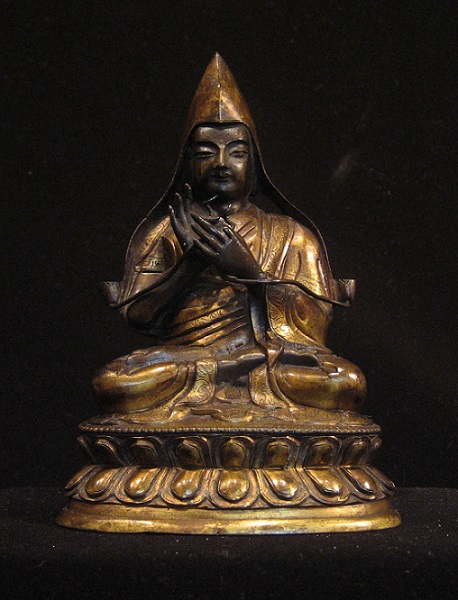

Unknown
Tibetan
Tsong Khapa, Founder of the Geluk Order, with “Turning the Wheel” Hand Gesture, 18th c. CE, late – early 19th c.
gilt bronze
SBMA, Gift of the Estate of Ina T. Campbell
1953.35.33
COMMENTS
Tsong-Kapa (1357-1419) was a great lama and teacher who believed in strict monastic life and wrote commentaries on Tantric Buddhist texts. He was the founder of the Gelukpa order known as the yellow hats in Tibet. He was of such importance that he was invited by a Chinese Ming emperor to visit China. He refused the invitation but sent gifts of gilt-bronze images.
In the 15th century the Gelukpa order established several great monasteries in Tibet. In the 16th century a Gelukpa abbot became the first Dalai Lama, who wielded both temporal and spiritual power. In the 17th century the 5th Dalai Lama erected the palace of the Dalai Lamas in Lhasa. Thus the Gelukpas came to dominate the religious and political life of the country until the Chinese takeover in the middle of the twentieth century.
Many of the historic lamas were first portrayed realistically. Later on they were deified, and their portraits were idealized.
The statue of Tsong-Kapa is seated cross-legged in a yogic position on a lotus pedestal. His hands are clasped in the gesture of meditation. He wears a monk’s cap and is covered by a robe incised with a delicate pattern. The statue is made by the lost-wax method of sculpture and is hollow. Sometimes these religious pieces were filled with relics or prayers.
This important lama continued to be venerated. At the annual festival of the Feast of Lights commemorating the ascension of Tsong-Kapa there were colorful rituals during which his tanka was displayed in the monastery courtyards at Lhasa.
- Patricia Cleek, SBMA Docent Council files,, n.d.
